 If you use Amazon regularly, be sure to check out AmazonSmile. You choose a charity and then Amazon gives them about half a percent of the money from your purchase. There’s very little work that needs to happen on your end to give the charity a nice donation. The hardest part is just remembering to start your session from smile.amazon.com so that your purchase qualifies for the program. There are lots of charities to pick from and if you run a 501c3 organization, you can add it. For those of you affiliated with the WELS, you might be interested to note that MLC is already on the list.
If you use Amazon regularly, be sure to check out AmazonSmile. You choose a charity and then Amazon gives them about half a percent of the money from your purchase. There’s very little work that needs to happen on your end to give the charity a nice donation. The hardest part is just remembering to start your session from smile.amazon.com so that your purchase qualifies for the program. There are lots of charities to pick from and if you run a 501c3 organization, you can add it. For those of you affiliated with the WELS, you might be interested to note that MLC is already on the list.
SprinRite in Hyper-V
You may remember a previous post about a product called SpinRite. It’s a hard drive maintenance and recovery tool, and it’s handy to have it in my bag of tricks. It has always been slightly annoying to use though because it requires me to dedicate a machine to it while it’s running and it can easily take a day (or even a week) to run.
Last week I had cause to run it again and after futzing around for a long time trying to get it to run on a spare laptop (it wouldn’t see the USB drive that was connected to the laptop), I started to wonder if I could get it to run in a virtual machine on my main desktop. SpinRite uses very low level commands to access the drive and I didn’t think that would work inside a VM, but why not try anyway?
Sure enough, it did work! Here are the steps I did:
- Attach the USB hard drive dock to my desktop and insert the drive.
- Power up the drive and wait for Disk Manager to recognize it.
- Set the disk to Offline mode.
- Create a new VM in Hyper-V (I’m running Windows 8.)
- Use SpinRite.exe to create an ISO and set the VM to boot that ISO.
From that point, SpinRite could see the drive, and I didn’t care how long it took to run because it wasn’t blocking me from doing other work on the machine. Perfect! Theoretically I could even spin up multiple instances of the VM and point it to multiple drives to parallelize a big recovery job.
Throwback Thursday – 1998 Senior Class Trip
Continuing the high school theme from last week, here’s a group picture from our senior class trip to Gettysburg and Washington D.C. I actually went to D.C. twice that summer. The first was with my classmates and the second was with my family. I most likely wore jean shorts and high tops on both trips as evidenced by this photo.
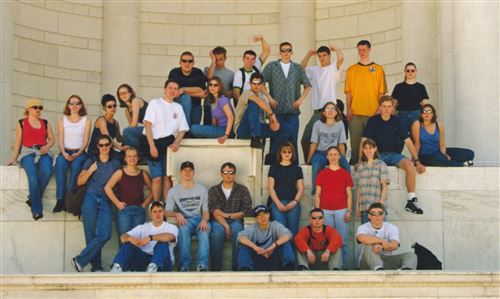
Anti-Aircraft Peak
We purchased a used hiking backpack earlier this year, but aside from walks around the neighborhood and working in the yard, we’ve never really used it. Now that the yard is finally done, we are able to spend more time together as a family so this past weekend, we headed out on a more legitimate hike.
Since we didn’t know how Elijah would react to the adventure, I picked a hike that I’ve been avoiding throughout the years because of it’s simplicity. Simple is good in this case though. So we headed for Cougar Mountain to hike around the Anti-Aircraft Peak area (hike #3 in the Beyond Mt. Si book.)
This area was the site of some post-WW2 90mm anti-aircraft guns to help guard the Puget Sound Area. They were later replaced with a site for the Nike Ajax Missile Defense. None of that stuff is still operational or even present on the mountain anymore.
The hike itself went pretty well. We made it about 1.4 miles before Elijah decided he wasn’t loving it. We stopped for a break, but given how unhappy he was when he got back in the pack, we decided to take one of the shorter options to finish the hike at around 2.2 miles. He was almost falling asleep at the very end so we probably could have completed the entire planned hike.
I’d call it mostly a success though. I want to make a few modifications to the backpack to help hold him in place better. I also need to avoid wearing a hat with a big long string that he can pull on! Assuming that he gets more used to riding back there, I think we could tackle some slightly longer trips.
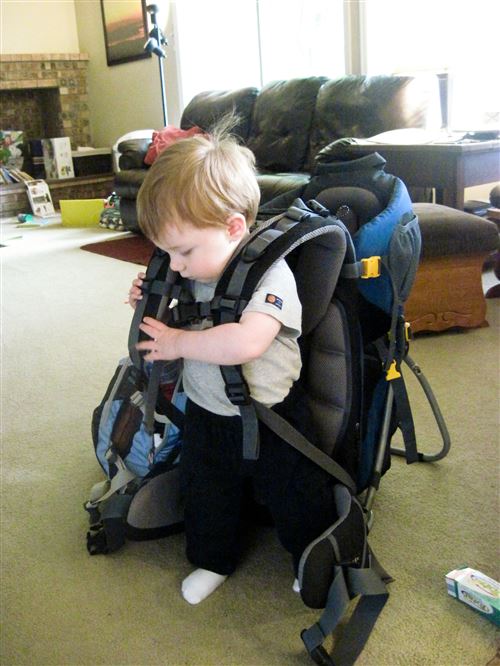

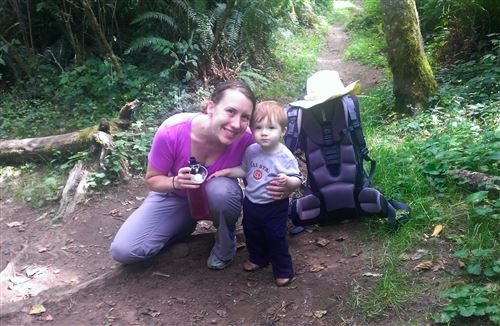
Xbox One
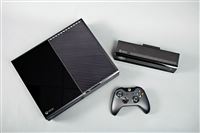 When the original Xbox came out, I was in college and couldn’t afford one. I’d never owned a game system in my life so it wasn’t a huge deal. I ended up winning one in a programming contest. When the Xbox 360 came out, I tried for weeks and weeks to find one in stock and finally did. I played that thing a LOT. When the Xbox One came out last fall, I was intrigued but with a new baby in the house, I had zero time to game. Well I still have zero time to game, but I recently picked up an Xbox One. I’ve only spent a half dozen hours or so playing it (Forza 5 of course), but it’s a nice device. Here are some of the key things I enjoy:
When the original Xbox came out, I was in college and couldn’t afford one. I’d never owned a game system in my life so it wasn’t a huge deal. I ended up winning one in a programming contest. When the Xbox 360 came out, I tried for weeks and weeks to find one in stock and finally did. I played that thing a LOT. When the Xbox One came out last fall, I was intrigued but with a new baby in the house, I had zero time to game. Well I still have zero time to game, but I recently picked up an Xbox One. I’ve only spent a half dozen hours or so playing it (Forza 5 of course), but it’s a nice device. Here are some of the key things I enjoy:
- Kinect v2 – I never bought the first Kinect because I didn’t think it worked that well, but this new one works much better than the first one.
- Voice – You can do a lot with voice commands through the Kinect. It remains to be seen how much I’ll actually use this but the geek in me is impressed with how well it works.
- Sign In – Kinect recognizes who you are and signs you in to your gamertag.
- Visuals – Graphics are obviously way better than the 360 but the difference isn’t as big as the leap in the previous generation (or at least it’s less noticeable.)
- Xbox OS – The UI is a lot nicer and there’s actually a good OS behind it all. By that I mean that you can run two apps at the same time and have one snapped to the side of the screen. So for example you could have Skype open on the side while you’re playing a game, but you couldn’t run two games at the same time of course.
- Digital Downloads – You can still buy discs but every single game is available as a download. Even though the game might take a long time to download, you can start playing it after just a few minutes. Prices are the same as if you bought discs. The advantage is that you never have to get up and swap discs! But you also lose out on reselling the game.
The biggest complaint I have (and I know I’m in the minority) is that the Xbox One doesn’t have a Windows Media Center extender application. That’s how I distribute TV around my house so I’ll need to keep an Xbox360 hooked up to each TV. I was hoping to replace one of them with the new Xbox One.
It’s an expensive toy, but if you’re a gamer, it’s a solid purchase.
Power BI
 I’ve written a couple times before about my Power BI project at work. The head of our group gave a presentation at the Worldwide Partner Conference that provides a nice overview of our future roadmap. To view it, go the WPC keynote page, click on “The Cloud for Modern Business” and then skip ahead to the 21 minute mark when James Phillips comes on stage.
I’ve written a couple times before about my Power BI project at work. The head of our group gave a presentation at the Worldwide Partner Conference that provides a nice overview of our future roadmap. To view it, go the WPC keynote page, click on “The Cloud for Modern Business” and then skip ahead to the 21 minute mark when James Phillips comes on stage.
Monthly Photos
Every month, Tyla and I sat Elijah down in our little homemade photo studio and took a series of pictures. It was an interesting photo challenge for me and I learned quite a bit. I’m not saying the results are professional, but I thought it was worth sharing what I learned.
- Consistent Lighting – The more consistent your lighting, the easier time you’ll have combining all the photos into a collage. We accomplished this by purchasing some halogen work lights. They’re very hot so I bounce the light off the ceiling instead of frying and blinding my son.
- Consistent Backdrop – Tyla bought a big white sheet and a big black sheet from a thrift store. In a corner of one room, I put 3M sticky hooks on the wall. I covered the top two corners of each sheet on both sides with packing tape and then punched a hole through the corners making a cheap grommet. Those holes go over the sticky hooks and bam, you’ve got a simple backdrop that’s easy to remove if you need the space.
- Consistent White Balance – I purchased a color calibration card and got in the habit of snapping one photo with that in the frame each time. This makes it super simple to get the white balance consistent across all the photos even if your lighting isn’t the same every time. Unfortunately I didn’t buy it until a few months into the project and I never could get those first few months to be just right (we also didn’t have the halogen lights until later in the project so that compounded the problem.)
- Reference Photos – If you’re going to take the same photos every month, make sure you list them out on a sheet of paper or just print off the first set that you get. At some point you’re bound to make a mistake and use the wrong prop with the wrong backdrop. You can see that in our dog photos.
- Tagging – I use Lightroom to store and edit my photos. Whether you use Lightroom too or if you just put them in a folder, make sure that as you’re editing the photos each month, you tag or otherwise set aside the ones that you’ll use when you group the whole series.
Every month seemed to present it’s own challenges. For example, he’s very mobile now so getting him to stay in one place long enough to take a photo is nearly impossible. Other times it was hard to find a time when he was happy and we were free. But in the end we got a fun series of pictures that shows how much he changed over the first year of his life. Kudos to Tyla for coming up with the idea.
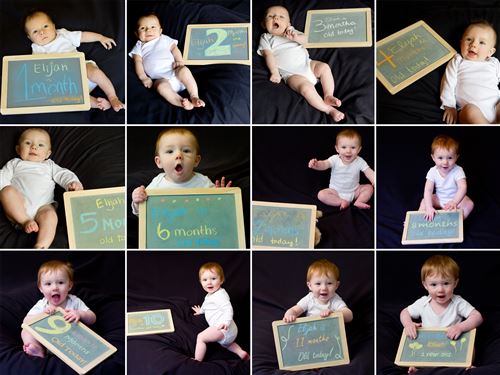


Throwback Thursday – April Fools 1998
For April Fools of my Senior year, we organized a prank on Pastor Schneider. At the beginning of religion class, we had the principal, Mr. Zanto, call Pastor into the office for a call from his wife (both of them were in on the joke.) Mr. Zanto agreed to watch our class while Pastor was gone.
As soon as Pastor left, we quickly moved all of the desks and even the overhead projector out the back door and set the classroom up outside. Getting the principal and his wife in on the gag turned out to be a good move because it mean that he couldn’t get too mad at us. A yearbook photographer was on hand to make sure this made it into the book.
Looking back at this photo, it’s interesting to see the people who weren’t looking back at the photo. Surely this was announced as “hey, smile for the camera” so I guess they didn’t think the joke was funny. Party poopers!
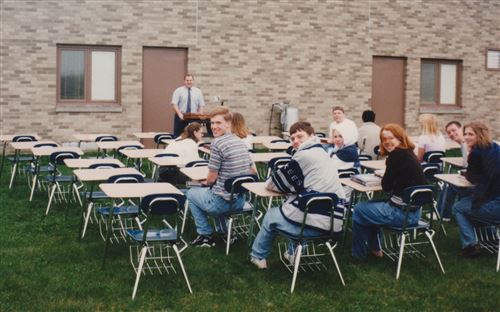
The Rod Groon Shew
I don’t remember the first time that Dad and I found the Red Green Show, but we spent a lot of time together watching it. One episode that really cracked us up was when Harold read a letter from a reader with a broken keyboard. The O and the E were reversed. This all happened before everything was on the internet so I didn’t know what episode number it was or anything like that.
Thankfully now every episode of the Red Green Show is available (legally!) on YouTube. That still didn’t help me much though because there are hundreds of episodes to sift through. Then I found this page that lists out the subject of the “Male Call” segment of the show! Sure enough, it says that in the episode “Homemade Cheese” a reader writes a letter with a broken keyboard!
I found the episode on YouTube. Here it is for your enjoyment. The segment starts at the 19:06 mark.

How We Plan Work
I first heard about Kanban when I was an intern at John Deere in 2001. They used it on their factory flow to reduce the amount of money tied up in logistics. Applying it to software is similar: keep your total work in progress as low as possible. I won’t go into all the details here. If you really want to learn more, you can read Brent’s blog. (One of his most popular posts is how he implemented this with his kids for chores.) He has also started a podcast called AB Testing. But anyway, here are a few keys to how the system works:
it seems a little complicated at first, but once you get into it, it’s liberating! Here are some of the things I love about it:
This system has made it very enjoyable to ramp up with the new team, see the contributions I’m making, and focus on one or two very specific and well-defined tasks.